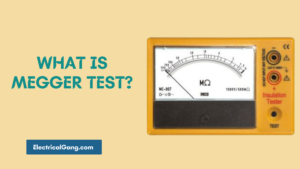
In today’s article, we will see what the Megger test is. And how to get the Megger test for the Cable and Transformer.
The Megger test has been used since 1889. The year 1920 has seen an increase in its popularity. Because for a long time, the device has been the same in its uses and testing purposes. Over the years, I have seen a real improvement in the quality of McGuire’s design and its tester. The Megger that is used nowadays is a high-quality alternative that is easy to use and relatively safe.
The Megger test is a way to check the use of insulation tester resistance meters, which helps in preventing the condition of electrical insulation.
The quality of insulation resistance of an electrical system decreases with time, and atmospheric environment, i.e., humidity, temperature, humidity, and dust particles.
It is also negatively affected by the presence of electrical and mechanical stresses. Therefore, it has become very important to check the IR (insulation resistance) of the equipment periodically to avoid any kind of danger to the organism or electric shock.
IR measures the durability of the insulator to withstand the service voltage without any current leakage path. It represents the concept of a general condition of the insulator. This is measured using a tool called the Megger test. Which can influence the DC voltage between its two probes, calculate itself, and then display the IR value.
What is the Megger Test?
A megger is an electric tool used to test the insulation resistance and winding of a machine to prevent damage to all large electric tools or machines.
Why is Megger Testing Done?
All electrical systems used in various spaces, such as industrial factories, hospitals, homes, automobiles, etc., are connected to each other using electrical wires. Proper connections should be made using electrical wires for good insulation to avoid any internal or external damage to the electrical system.
A tool called a mugger is used to check if the connection is made properly. In the insulation test, we send the test voltage down through the electrical system.
To check if there is any type of electrical current passing through the insulated wiring to all the devices of the machine. To do this, we send a voltage higher than its capacity in the case of a matte part to test the pressure of the wire and see how well it performs.
In everyday life, we can see that everyone has different types of pipes in their house for water connection. The plumber checks the corner pipe properly to ensure that no water leakage remains. For example, if we consider a water pipe with a pressure gauge and a pump at the end. The pipe, on the other hand, is closed.
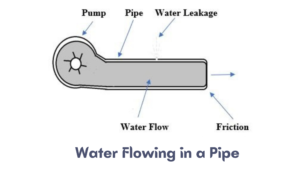
Case (i): In this, the plumber wants to show that there is no leakage of any kind in the pipe. It will apply mini pressure on the pipe. Piping is OK, which means there is no leakage of any kind.
Case (ii): However it applies excellent pressure to know the error. If there is a small hole in the pipe and water is flowing inside the pipe, it will leak in a small amount.
This will mean that there is a loss of water and there is a disturbance of the pointer in the pressure gauge, based on which the problem can be detected and even fixed similarly if we do a pressure test in an electrical system. In it, we apply a high voltage, and where we follow the ohms law, a pressure gauge is used to measure the resistance.
What is Good Insulation?
According to Ohm’s law
V = IR …… (1)
V = voltage; I = flowing stream; R = resistance.
R = V/I …… (2)
If we assume V to be constant, then “I” changes, then “R” also changes
Similar to the example of plumbing work in wire
Where insulation = pipe carrying water

Case (i): If we have a small amount of current flowing while applying a constant voltage, the resistance will decrease.
Case (ii): If we have no current flow, the resistance will increase. , Voluntarily when we do a pressure test in an electrical system, we have to maintain a high value of resistance.
How is Megger Testing Performed?
The multimeter is used as an insulator tester in some situations, and the multimeter is mostly used for continuity testing. Also, a special tool called an insulation tester is used to detect and test leakage currents in some normal conditions or overload conditions.
We measure electrical leakage in wires, and the results are also reliable. Because when we are testing, we will pass an electric current from that device. We check the level of the electrical insulators in any device, like a motor, cable, or transformer. The result can be measured in terms of megaohms.
The procedure for a megger test or insulation resistance test is as follows
- We will first disconnect all the line and neutral terminals of the transformer.
- Mager’s leads are connected to the LV and HV bushing studs to measure the value of insulation resistance IR between the LV and HV windings.
- Mager’s leads are connected to HV bushing studs and a transformer tank earth point to measure the value of IR between the HV winding and the earth.
- Similarly, Mager’s leads are connected to LV bushing studs and transformer tank earth points to measure the value of IR between the LV winding and the earth.
The following formula gives the recommended minimum value for IR. Its unit is Megahome (MΩ). Criteria of value give us an idea of whether the cable is bad or right.
IRmin (in MΩ) = kV + 1
Where kV = rated service voltage in kV
When the measured IR is about 10 to 100 times greater than the IRmin obtained from the above equation.
The general measurement method involves measuring IR between three phases and between individual phases and the earth. IR is also measured for the body of the instrument. The process varies from device to device. Different voltage layers apply to them cable-based depending on the rating and size.
The voltage level applied to test the Megger of 33 kV HT cable is 5000 V, and the value of IR can be anywhere between 1 GigaOhm to 200 GigaOhm.
When we use a multimeter, we can measure the resistance, voltage, and current. Based on that, I hope you guys are familiar with the word insulation. To put it simply, when properly insulated or protected, current can flow through a specific conductor wire. This wire can be inside a building, appliances, electric motor, or in any other space.
Working of Megger
- Electrical systems with high voltages require 1000V to 5000V for testing.
- The deflecting coil is always connected in series so that the current that flows tests the circuit.
- This circuit is connected to its entire PC coil.
- To protect the circuit, two resistors (current coil resistor and pressure coil resistor) are connected in series and also use two coils like control coil and deflecting coil.
- In a manually operated megger, a test voltage is generated by the EMI effect.
- When the voltage rises, the deflection pointer shows infinity similarly if the flow curvature is increased.
- The pointer displays zero.
Therefore
Torque α Voltage, …..( 3 )
Torque α 1/Current. ….( 4 )
In the case of a short circuit, the pointer displays 0 readings.
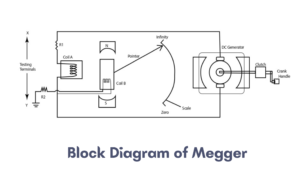
Megger Test for Cables
The insulation resistance test for a cable using a megger is a continuity test, where the power of the circuit is off.
For example, if the capacity of the cable is 5 amp, we cannot send current less than 5 amp or more. If we send more than 5 amp current, the cable may fail. So we test the insulation resistance. To find out how much resistance it can prevent. Insulation resistance is always measured in megaohms. The device used to measure IR is called a megger.
This cable is used in the power system, where we perform IR tests for proper maintenance of the system. So that we can know the IR value for better performance.
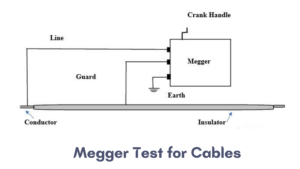
Construction
Megger is a type of DC generator and consists of three terminals.
- Line terminal,
- Guard terminal,
- and the earth terminal.
In the circuit shown above, the guard is connected to an insulator, the line terminal is connected to the conductor to be tested, and the earth pin is ground.
Higher Resistance = Higher Insulation = No current flow.
Steps
- Connect the circuit as shown in the figure above.
- Press Megger’s test button so that Megger will generate a current.
- The current flows through the cable, and the resistance is noted in the scale, which is between 35 to 100 megaohms.
- Note to maintain this contact for 30 to 60 seconds.
- Acceptable IR for electrical cable = 1 Mega Ohm for 1000 V.
Result
If the range shown is between 35 and 100 megohms, then this means that it is a good insulator.
Megger Test for Transformer
A transformer is an electrical device that operates on the principle of mutual induction. IR tests are performed to ensure that no flow leakage occurs in the transformer.
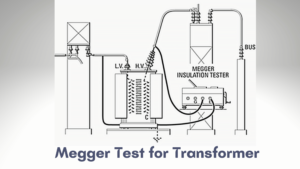
Working Procedure
The insulation measures for testing the transformer are as follows.
- Step 1: Remove all terminal connections.
- Step 2: Connection is made between two terminals of megger and LV low voltage and high voltage bushing studs of HV transformer. So that we can record the ranges of IR values between LV – HV.
- Step 3: From the Megger lead, a connection is made between the transformer high voltage bushing stud and the transformer earth terminal. IR is measured between high voltage-ground transformer windings.
- Step 4: When the low voltage of the megger lead transformer is connected to the bushing stud and the transformer earth terminal. IR Low voltage windings – measured between ground.
Result
- IR values are recorded every 10 seconds, 15 seconds, and 1 minute.
- As the applied voltage increases, the insulation resistance value also increases.
- The coefficient of absorption is given as 1 min value/15sec.
- The polarization of the index is a 10 min value/1 min value.
Types of Megger Test
The Megger Test can be divided into two types as follows
| Sr. No. | Types of Megger Test |
| #1. | Electronic Type (Battery Operated) |
| #2. | Manual Type (Hand Operated) |
Megger Test Safety Precautions
When using the Megger test, you may be injured, or the equipment we are working on may be damaged if the following minimum requirements are not observed.
- Use only the Megger test on high resistance measurements. Check two different conductors, such as insulation size or cable.
- Do not try to block the test leads when the handle is cranking. Completely de-energize and discharge the circuit before connecting the megger test.
- If possible, disconnect the item being checked from another cycle before using the Megger test.
Advantages of Electronic Type Megger Test
The benefits of the Electronic Type Megger Test are as follows
- The level of accuracy is very high.
- The value of IR is the digital type and easy to read.
- Work can be done easily, even by a single person.
- Works perfectly even in very crowded spaces.
- Very easy and safe to use.
Advantages of the Megger Test
The advantages of the megger instrument for the test program are as follows:
- Emergency failure in the power system can be minimized.
- Repairs can be predicted in advance.
- The forecast leads to a longer lifespan of the electrical system, which is being tested.
- Asset management.
- Life expectancy tools of forecasting.
- Analysis of the status of active equipment.
Most Commonly Asked Questions

What is a good Megger test result?
Any reading between 2 megaohm and 1000 megaohm is generally considered a good reading. Unless other problems have been reported. Anything less than 2 megohm indicates an insulation problem.
What is Megger, and is it working?
A megger is an electrical device that we use to determine the range of resistance between zero and infinity. Initially, the pointer is in the state of infinity, distorted when an emf is generated from infinity to zero, which is based on Ohm’s law.
What is a bad Megger reading?
If the Megger reads the resistance below 1,000 ohms on our meter after 60 seconds from the start, then in that case, the cable has failed, and the cable should be removed. If the Megger reads the resistance between 1 and 1.25 on your meter, the cable is passed.
Like this post? Could you share it with your friends?
Suggested Read –
- Netflix Not Working on Vizio Smart TV
- The Ultimate Guide to Fixing Hisense TV Problems
- Alexa Device Is Unresponsive | Here’s How to Fix It
- What is a Stepper Motor? | Types of Stepper Motors
- Buchholz Relay in Transformers | The Definitive Guide
Final Thoughts
Here we have seen the insulation resistance or megger testing for electrical systems as described above. The insulation resistance or megger test process and the results are done on cable and transformer, with caution and advantages.